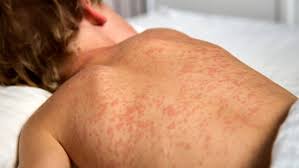
 Measles and rubella are both viral exanthems.
Measles and rubella are both viral exanthems.
Measles and rubella have distinct clinical and epidemiological features.
Measles is caused by the measles virus, a highly contagious pathogen transmitted via respiratory droplets.
The incubation period averages 11-12 days.
Symptoms include high fever, cough, coryza, and conjunctivitis, followed by a characteristic maculopapular rash.
The rash starts on the face and spreads to the trunk and extremities.
Koplik spots, small bluish-white plaques on the buccal mucosa, are pathognomonic for measles.
Complications from measles can be severe, including pneumonia, encephalitis, and subacute sclerosing panencephalitis (SSPE).
Rubella, also known as German measles.
Rubella is caused by the rubella virus and is generally milder than measles.
The incubation period is about 14 days.
Symptoms include a low-grade fever, lymphadenopathy, and a maculopapular rash that starts on the face and quickly spreads.
Up to 50% of rubella infections can be asymptomatic.
While rubella is usually mild, infection during early pregnancy can lead to congenital rubella syndrome, associated with birth defects such as cataracts, heart disease, and hearing impair.
Both diseases are preventable by vaccination, typically administered as the combined measles-mumps-rubella (MMR) vaccine.
